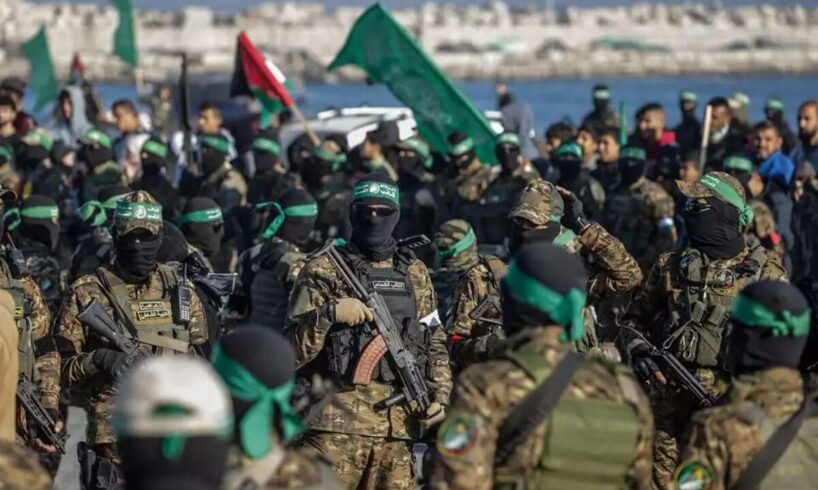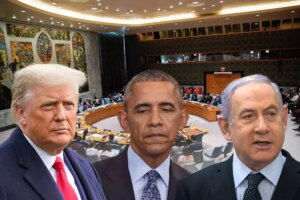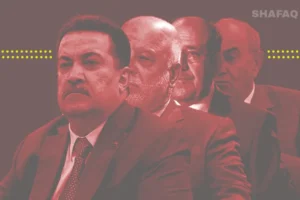
Hamas is preparing the ground for the possibality of rejecting President Trump’s plan. The outline for ending the war may find some support among ordinary Gazans, but for figures inside the terrorist organization it amounts to a “surrender program.” The preservation of the Philadelphi corridor, the evacuation route, the transfer of authority to an international council, and the handing over of rockets leave Hamas exposed to continued Israeli strikes and strip it of relevance.
It is therefore unsurprising that leaks have appeared about its demands for a withdrawal timetable and guarantees against renewed fighting. Those leaks appear intended to wrap an eventual refusal in a more palatable package, perhaps in hopes of getting a better offer later.
Hamas terrorists accompanied by children celebrate in the streets of Gaza. Photo: Reuters Reuters
On the night between Monday and Tuesday, Islamic Jihad Secretary-General Ziad al-Nakhala described the plan as a complete adoption of Israel’s position and “a recipe for continued aggression.” A smaller militant faction called the outline “an explicit demand for the Palestinians to surrender to Netanyahu.” It appears the role of al-Nakhala and that faction of Fatah hardliners is to provide cover for Hamas. Throughout the war Hamas coordinated positions with its partners. Now it is expected to use them to present its stance as a “Palestinian consensus,” despite the Palestinian Authority’s support for the plan.
Hamas’s problem is that the alternative does not look appealing. Its pariah status in the Middle East has been reflected in broad Arab support for the American plan. A senior Emirati official described it as “a humanitarian and political opportunity not to be missed.” That means that if Hamas refuses, Israel would gain broad legitimacy to continue the war and crush its remaining forces in Gaza. With every senior figure eliminated, the “Hezbollah model” that the terrorist organization has relied on loses relevance. Lebanon was run for many years with Hassan Nasrallah influencing matters from behind the scenes. Today it is very difficult in Gaza to find a Hamas leader who still commands that kind of standing.
Trump at the press conference: “This is a historic day.” Photo: Reuters Reuters
Trump’s plan also opens the door to further internal disputes within Hamas. Not all lifetime prisoners are slated for release – ozens will remain in jail while 250 will be freed. That alone is enough to spark internal debates about which top militants will be released and from which areas. Another point of friction is that some senior figures are trying to consolidate their positions within the movement ahead of a leadership contest. No one wants to be seen as the one who “surrendered” to a plan of Israel and the US. It is worth noting that the pro-Iranian camp opposes President Trump’s outline. Houthi spokesmen in Yemen described it as “a choice between surrender and death without resistance” and as granting Israel legitimacy to continue fighting.
Moreover, divisions appear to exist between Hamas’s external negotiating bureau and the layer of officials in Gaza. This week we revealed on the Israel Hayom website the full Gaza outline for ending the war put forward by Gaza figures. Among the signatories were merchants, public figures and Khan Younis mayor and senior Hamas official Alaa al-Din al-Batta. In that outline the authors agree to the immediate transfer of living hostages (albeit to an international committee), to declaring the handover of “what remains of the heavy weapons” and to handing over the reins of negotiations to the Palestinian Authority. The very existence of the plan challenges the authority of the external bureau.
Strikes in Gaza City None
It should be said that the Gaza outline is also far from President Trump’s plan. While there is readiness for a Palestinian technocratic mechanism backed by the Arab League to take over governance, would an international council led by former British prime minister Tony Blair be welcomed with open arms? This week a senior Hamas official, Hossam Badran, questioned by what right the British politician would assume control of Gaza and called him an unwelcome figure. In addition, even the minimalists in Hamas who support the Gaza outline demand a full Israeli withdrawal from the Strip at the end of the initial 60-day period.
Given this, it would be very surprising to see Hamas agree unconditionally to President Trump’s plan. Such acceptance would be a spectacular capitulation. It therefore appears that the organization is devoting most of its efforts to figuring out how to evade the trap laid for it. As noted, it may announce acceptance but hobble implementation with caveats that pass the ball back to the Israeli court. Even so, unlike other turning points during the war, this time Hamas’s room for refusal is unusually narrow.





